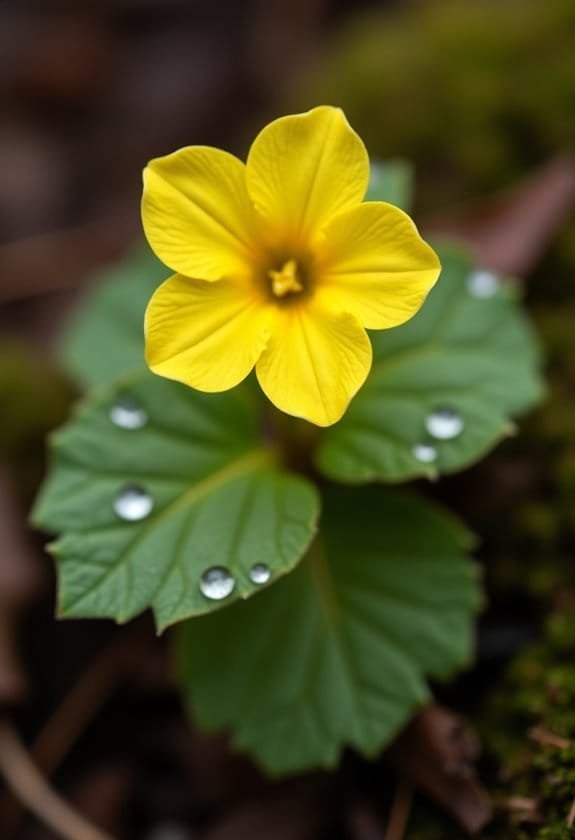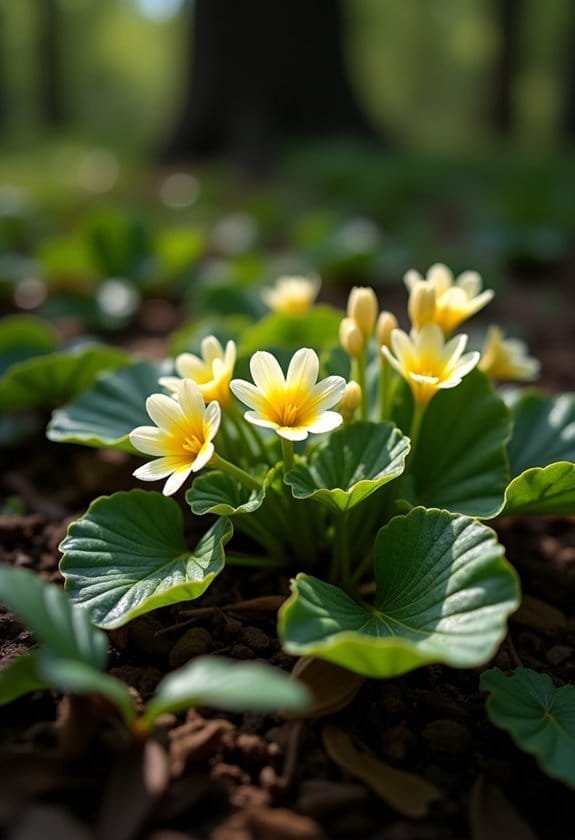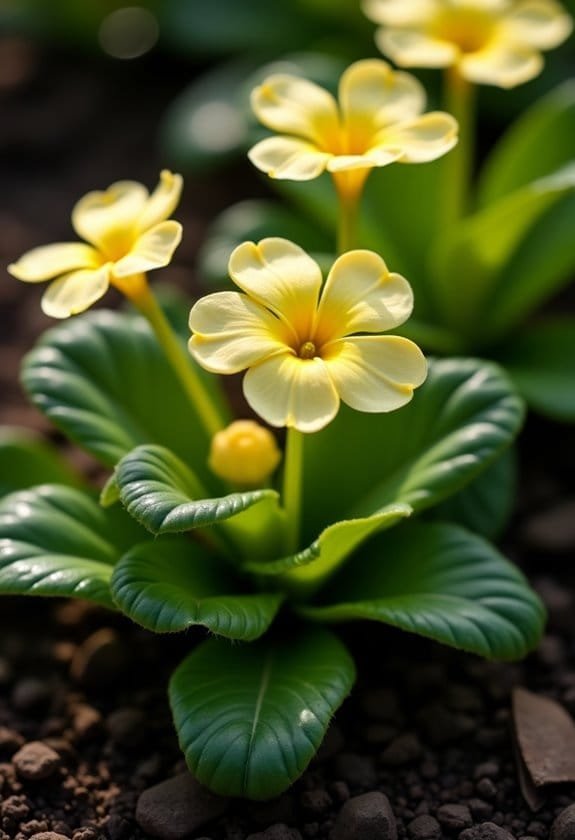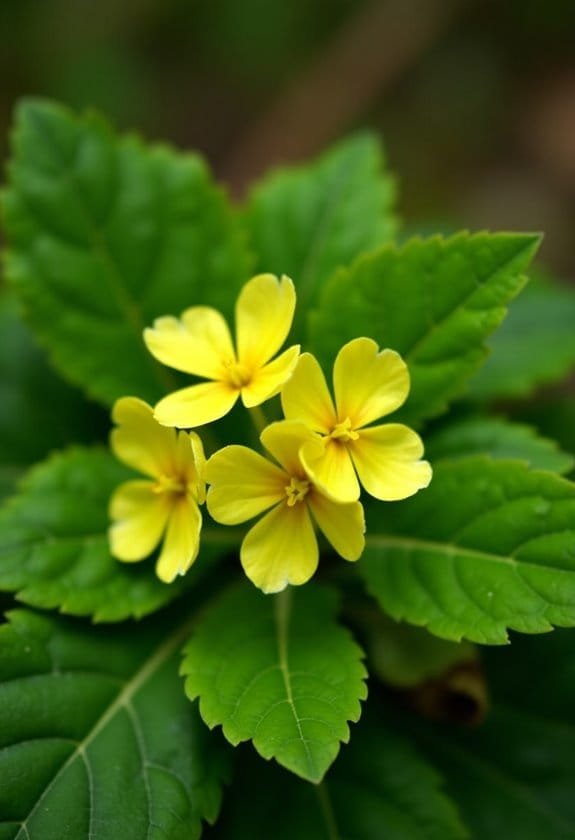Primula vulgaris, commonly known as primrose, is a cherished European wildflower that displays pale yellow blooms from late winter through mid-spring. It's a compact plant, growing 4-6 inches tall with distinctive wrinkled leaves arranged in basal rosettes. The plant thrives in humus-rich, well-draining soil and partial shade, making it perfect for woodland gardens and early spring displays. Its nectar-rich flowers, featuring unique pin and thrum forms, serve as essential early-season food sources for bees and butterflies. While relatively easy to maintain, it requires consistent moisture and protection from intense sun. These adaptable perennials hold many fascinating secrets within their delicate petals.
Main Points
- Primula vulgaris is a compact flowering plant with pale yellow blooms, commonly known as Wild Primrose or English Primrose.
- The plant grows 4-6 inches tall, featuring wrinkled basal leaves and flowers that bloom from late winter through mid-spring.
- It thrives in partial shade and requires well-draining, humus-rich soil with consistent moisture and a neutral pH.
- The flowers attract bees and butterflies, with two distinct flower forms promoting cross-pollination for genetic diversity.
- Native to Southern and Western Europe, it's celebrated in British culture and commonly used in woodland gardens and spring displays.
Introduction

Primula vulgaris, commonly known as the primrose, stands as one of Europe's most cherished woodland flowers.
This semi-evergreen perennial has earned its reputation through its distinctive pale yellow blooms, which emerge as winter retreats and continue their display well into spring's embrace.
The plant's scientific classification within the genus Primula reflects its status as a true harbinger of spring, combining its compact growth pattern of 4-6 inches in height with remarkable adaptability to various garden environments.
Common Name
The plant's most widely recognized name is "Primrose," though it's also commonly called "Wild Primrose" or "English Primrose" throughout its native range in Southern and Western Europe. The scientific designation Primula vulgaris includes the Latin term "vulgaris," which translates to "common," reflecting the plant's widespread distribution and familiar presence in various habitats.
This beloved flowering plant has earned its place in both botanical classification and cultural significance, particularly in British traditions where it's celebrated during Primrose Day. Its common name perfectly captures the essence of this early spring bloomer, which produces delicate, typically pale yellow blossoms that serve as harbingers of winter's end.
While the classic yellow variety might be the most recognizable form, the Primrose also displays its charm in white and pink variations, each carrying the characteristic sweet fragrance that has endeared it to gardeners and naturalists alike.
The multiple common names associated with Primula vulgaris speak to its historical importance and widespread cultivation across European gardens and woodlands.
Scientific Name
Beyond its familiar common names, this cherished flowering plant bears the scientific designation Primula vulgaris, formally established within botanical taxonomy. The Latin epithet "vulgaris" translates to "commonly seen," reflecting the species' widespread presence throughout its natural range, while Primula refers to its early-blooming nature as a harbinger of spring.
Originally classified as Primula acaulis, botanical researchers later revised the taxonomic designation to its current nomenclature, demonstrating the evolving nature of scientific classification systems. The species belongs to the family Primulaceae, which encompasses numerous flowering plants characterized by their distinctive five-petaled blooms and basal rosette growth pattern.
Within the scientific framework, botanists recognize three distinct subspecies of Primula vulgaris: subspecies vulgaris, balearica, and sibthorpii, each displaying unique morphological adaptations to their respective habitats.
This taxonomic organization has proven invaluable for researchers studying the plant's distribution across Western and Southern Europe, North Africa, and the Caucasus region, where different subspecies have developed specialized characteristics in response to local environmental conditions.
Overview
Widely cherished across European gardens and woodlands, Primula vulgaris stands as one of nature's earliest harbingers of spring, producing delicate pale yellow blooms from late winter through mid-spring.
These compact, semi-evergreen perennials create a stunning display with their distinctive flowers, which measure approximately one inch across and feature a deeper yellow center that adds visual depth to their appearance.
The characteristic primroses look encompasses a rosette formation, where the flowers emerge from a dense cluster of leaves at the plant's base, creating a naturally organized display that's both elegant and understated.
In their preferred habitat, these resilient plants flourish in humus-rich soils that maintain consistent moisture levels, particularly excelling in partially shaded locations, though they demonstrate remarkable adaptability to full sun exposure in cooler climates.
Beyond their ornamental value, which has earned them the prestigious Royal Horticultural Society's Award of Garden Merit, these hardy perennials play a crucial role in supporting local ecosystems.
Their nectar-rich blooms serve as essential resources for various pollinators, including bees and butterflies, making them valuable contributors to biodiversity in both cultivated and natural settings.
Key Features
The Primula vulgaris displays a compact growth habit, reaching heights of 4-6 inches (10-15 cm) with a spread of 4-9 inches (10-22 cm) in ideal conditions.
Its distinctive pale yellow flowers, measuring approximately 1 inch (2.5 cm) across, emerge from wrinkled, basal rosette leaves and feature deep yellow centers that act as beacons for pollinators.
These enchanting blooms grace gardens from late winter through mid-spring, making the primrose a valuable early-season source of color when many other plants remain dormant.
Growth Size
Primula vulgaris consistently maintains a compact growth habit, reaching heights of 4-6 inches (10-15 cm) with a spread of 4-9 inches (10-22 cm). These diminutive dimensions make it an ideal choice for garden borders and woodland settings, where its pale yellow blooms create striking visual displays during the late winter and spring seasons.
At the plant's base, a rosette of distinctively wrinkled leaves develops, measuring between 5-25 centimeters in length and 2-6 centimeters in width. This foliage creates a sturdy foundation from which delicate flower stems emerge, each supporting blooms approximately 1 inch (2.5 cm) in diameter.
The plant's modest size belies its remarkable reproductive capabilities, as it readily self-seeds throughout favorable growing areas.
The compact nature of Primula vulgaris allows it to thrive in various garden settings without overwhelming neighboring plants. Its natural spreading tendency, facilitated by self-seeding, enables it to establish substantial colonies over time while maintaining its characteristically modest height, creating dense clusters that serve as excellent ground cover in partially shaded locations.
Appearance
Standing gracefully in woodland gardens, common primroses showcase delicate pale yellow flowers with deep golden centers, measuring 1-2 inches (2.5-5 cm) across. These charming blooms emerge atop woolly stalks, clustered together in an enchanting display that persists from late winter through mid-spring, typically December to May.
The plant's distinctive foliage forms a compact rosette at the base, featuring wrinkled leaves that span 5-25 cm in length and 2-6 cm in width. These leaves possess irregular margins and display a notable characteristic: their undersides are covered with fine hairs, adding texture to their appearance. The overall structure maintains a neat, organized form that complements its floral display.
One of the most fascinating aspects of Primula vulgaris lies in its flower structure. The species exhibits heterostylous flowers, meaning they come in two distinct forms: pin and thrum. This unique reproductive adaptation promotes cross-pollination between different flower types, demonstrating nature's intricate design for genetic diversity.
The combination of delicate yellow blooms and textured foliage creates an appealing visual harmony in garden settings.
Flowering Season
During its remarkable flowering season, Primula vulgaris bursts into bloom from late winter through mid-spring, creating a vibrant carpet of pale yellow flowers that persists for up to six months. The flowering period typically extends from December through May, when these resilient plants showcase their delicate blooms measuring 1 to 2 inches in diameter.
Each Primula plant produces an abundance of flowers, transforming gardens and natural landscapes into enchanting displays of soft yellow petals complemented by deeper yellow-orange centers.
The flowering season plays an essential role in the plant's reproductive cycle, as these hermaphroditic blooms employ a sophisticated heterostylous mechanism that necessitates cross-pollination for peak seed production. This characteristic guarantees genetic diversity within Primula populations while supporting local ecosystem health.
The extended flowering period of Primula vulgaris serves as a significant early-season resource for various pollinators, particularly bees and butterflies emerging from winter dormancy.
This timing makes the species an especially valuable component of garden ecosystems, providing sustenance when many other flowering plants remain dormant.
Growing Requirements

Primula vulgaris thrives in locations that offer part shade conditions, though it can adapt to full sun in regions with mild summers.
The plant demands consistently moist, humus-rich soil with a neutral pH between 6.0 and 8.0, making well-draining clay or loam enriched with organic matter an ideal growing medium.
While these primroses demonstrate remarkable adaptability to various growing conditions, they require protection from intense afternoon sun and benefit from regular moisture monitoring, especially during warmer periods when soil can quickly dry out.
Light
The light requirements of Primula vulgaris center around partial shade conditions, making it perfectly suited for woodland gardens and areas with filtered sunlight. In well-drained soils, these delicate plants flourish when they receive dappled light that mimics their natural forest habitat, where towering trees provide intermittent protection from direct rays.
While Primula vulgaris demonstrates some adaptability to full sun exposure in regions with mild summers, careful attention must be paid to protecting the plants from intense afternoon sunlight, which can cause leaf scorching and reduced flowering.
The ideal light balance supports the plant's characteristic blooming period, which extends from late winter through mid-spring, producing their cherished displays of delicate petals.
Gardeners should monitor their primroses' light exposure throughout the growing season, as excessive direct sunlight can trigger plant stress and diminish blooming potential.
The perfect location provides morning sun followed by afternoon shade, creating a microclimate that maintains soil moisture while supporting robust growth and prolonged flowering periods.
Soil
For successful cultivation, Primula vulgaris demands humus-rich soil with consistent moisture levels and good drainage. The plant flourishes in environments where the soil composition includes substantial organic matter, particularly in clay or loam-based mixtures that effectively retain moisture while preventing waterlogged conditions.
The ideal soil pH for Primula vulgaris falls within the neutral range of 6.0 to 8.0, which promotes optimal nutrient absorption and supports vigorous growth throughout the growing season. Gardeners should regularly monitor the soil's moisture content, as these delicate plants require a careful balance between consistent hydration and adequate drainage.
Like a well-calibrated instrument, the soil should maintain steady moisture levels without becoming saturated, which could lead to devastating root rot.
When preparing the growing medium, incorporating organic materials such as well-rotted compost or leaf mold can considerably enhance the soil structure and fertility. This enriched environment creates an ideal foundation for the plant's extensive root system, enabling it to establish strong networks that support abundant flowering and robust foliage development throughout its growing cycle.
Water
Maintaining proper water balance builds upon the soil's moisture-retention qualities for Primula vulgaris success. These delicate perennials demand consistent hydration throughout their growing cycle, with particular attention required during their peak flowering period from late winter through mid-spring.
In regions with moderate summers, Primula vulgaris thrives when planted in partially shaded locations where moist soils can be maintained without becoming waterlogged. The plant's root system responds best to a steady moisture level that mimics its natural woodland habitat, requiring gardeners to monitor soil conditions regularly.
During extended dry spells, increased watering frequency becomes vital to prevent stress-induced decline in plant health and flowering performance. The relationship between water management and location proves particularly significant, as specimens planted in full sun locations require more frequent irrigation to maintain ideal growing conditions.
Successful cultivation hinges on striking a delicate balance: providing enough moisture to support robust growth while avoiding oversaturation that could lead to root problems. Regular monitoring of soil moisture levels, especially during active growth periods, guarantees these cherished spring bloomers receive the hydration they need to flourish.
Temperature
Temperature ranges play an essential role in Primula vulgaris cultivation, with these hardy perennials flourishing in USDA zones 4 through 8.
These adaptable plants demonstrate remarkable resilience across varying climates, though they exhibit clear preferences for moderate conditions that mirror their natural woodland habitats.
For ideal growth, Primula thrives in environments where temperatures remain consistently cool, particularly during the summer months when heat stress can become a significant concern.
In regions with warmer climates, afternoon shade becomes vital for maintaining appropriate temperature levels, as excessive heat can cause wilting and reduced flowering.
While these plants can tolerate full sun exposure in areas with cooler summers, they perform best when protected from intense midday heat.
The temperature requirements of Primula make them particularly well-suited for climates characterized by mild winters and cool summers.
Their ability to withstand colder temperatures in winter, coupled with their need for moderation during warmer months, reflects their evolutionary adaptation to temperate woodland conditions.
This temperature preference aligns perfectly with their requirement for consistent soil moisture, creating an interconnected relationship between heat tolerance and hydration needs.
Pollinator Criteria
Primula vulgaris relies on a diverse array of pollinators, including bumblebees, butterflies, and hairy flies, which are drawn to its distinctive flowers during the late winter to spring blooming period.
The plant's unique heterostylous flowering system, featuring both pin and thrum forms, requires cross-pollination between different flower types to guarantee successful reproduction and maintain genetic diversity.
These early-blooming flowers serve as an essential food source for emerging pollinators, creating a mutually beneficial relationship that supports both the plant's reproduction and the survival of various pollinating species.
Attracted Pollinators
Various pollinators are naturally drawn to Primula vulgaris, with bumblebees and hairy flies serving as the most effective agents for cross-pollination. These industrious insects are particularly well-suited to navigate the plant's hermaphrodite and heterostylous flower structure, ensuring successful reproduction through their foraging activities.
The primrose's delicate scent and vibrant colors create an irresistible beacon for a diverse array of visitors, including butterflies, beetles, and flies, who seek out its sweet nectar rewards. During its extended flowering period from late winter through mid-spring, Primula vulgaris provides vital sustenance for pollinators emerging from their winter dormancy, making it an essential early-season food source in both gardens and natural habitats.
The plant's ecological significance extends beyond its role as a nectar provider, as its seeds feature specialized structures called elaiosomes that attract ants. This remarkable adaptation promotes seed dispersal while simultaneously supporting local ant populations, demonstrating how Primula vulgaris contributes to the intricate web of relationships that maintain ecosystem stability and enhance biodiversity within its environment.
Pollination Method
The most distinctive feature of Primula vulgaris's pollination system lies in its heterostylous nature, where flowers exhibit either pin or thrum forms. This remarkable adaptation guarantees cross-pollination between the two morphs, effectively preventing self-fertilization and promoting genetic diversity within populations.
While the red spider might occasionally visit these flowers, it's not among the primary pollinators that facilitate reproduction.
The plant's sophisticated pollination mechanism relies on the precise positioning of reproductive structures, with pin flowers featuring extended styles and low anthers, while thrum flowers display the opposite arrangement. This structural differentiation works in concert with the flower's enticing fragrance to attract essential pollinators, including bumblebees, hairy flies, and small beetles.
When these insects visit the flowers, pollen adheres to specific parts of their bodies, corresponding to the height of the reproductive structures they encounter.
The success of this pollination strategy is further enhanced by the presence of elaiosomes on the seeds, which attract ants for dispersal, creating an integrated system that guarantees both effective pollination and seed distribution throughout the habitat.
Care & Maintenance

Successful cultivation of Primula vulgaris starts with early autumn planting in humus-rich, consistently moist soil that mimics its natural woodland habitat.
Regular maintenance includes vigilant pest monitoring for common threats like aphids and slugs, coupled with consistent watering schedules to maintain ideal soil moisture levels throughout the growing season.
These hardy perennials respond well to early spring fertilization with balanced organic nutrients, which supports their vigorous growth pattern and guarantees abundant flowering alongside compatible shade-loving companions such as ferns and hostas.
Planting Tips
Growing Primula vulgaris successfully depends on proper timing and location selection. Early fall planting provides the ideal window for establishment, allowing these delicate perennials to develop robust root systems before winter's arrival.
Gardeners should carefully select a spot that offers protection from intense afternoon sunlight while providing sufficient dappled shade for these shade-loving plants.
The soil composition plays a significant role in Primula's development, requiring a well-balanced mixture that retains moisture without becoming waterlogged. A humus-rich medium with a neutral pH between 6.0 and 8.0 creates the perfect growing environment, supporting healthy root growth and abundant blooming.
When preparing the planting site, incorporate organic matter to improve drainage and nutrient availability.
To guarantee successful establishment, space plants approximately 6-8 inches apart, allowing sufficient room for mature growth while maintaining a cohesive display.
Monitor the newly planted specimens closely, watching for common pests like aphids and slugs that can compromise plant health.
Regular maintenance, including consistent moisture levels and early spring fertilization, helps create ideal conditions for these charming woodland flowers to thrive.
Ongoing Care
Once established, Primula vulgaris demands consistent attention to maintain its vibrant display throughout the growing season. The plant's ongoing care centers primarily around maintaining proper soil moisture, with regular watering being fundamental during dry spells to support healthy growth and abundant flowering.
To guarantee ideal performance, fertilization plays a significant role in Primula's development. Applying a balanced, slow-release fertilizer in early spring provides the necessary nutrients for robust blooming and sustained health throughout the season.
Regular monitoring for common pests, particularly slugs and aphids, is fundamental, as these invaders can quickly compromise the plant's aesthetic appeal and well-being.
Post-blooming maintenance involves the careful removal of spent flowers and deteriorating foliage, which not only enhances the plant's appearance but also reduces the risk of disease development.
As Primula readily self-seeds, gardeners should manage seedling populations through selective thinning, guaranteeing each plant has adequate space to develop its characteristic rosette form. This practice prevents overcrowding and maintains the ideal growing conditions necessary for these cherished spring bloomers.
Suggested Companions
Within a well-planned garden, Primula vulgaris pairs harmoniously with carefully selected companion plants that share its cultural requirements. The common primrose thrives particularly well alongside moisture-loving perennials such as ferns and hostas, which create a natural woodland aesthetic while maintaining consistent soil conditions.
For maximum visual impact and ecological benefit, combining primroses with spring-flowering companions like bluebells and forget-me-nots creates stunning color combinations that attract vital pollinators to the garden. Ground-level companions play an equally important role, with creeping thyme and moss serving as living mulch that helps maintain ideal soil moisture levels for these delicate plants.
When designing primrose plantings, it's important to evaluate spatial relationships and avoid aggressive competitors. While daylilies and ornamental grasses might seem appealing choices, their vigorous growth habits can overwhelm the more demure primroses.
Instead, focus on creating balanced groupings that account for each plant's mature size, allowing sufficient space for the primroses to establish their characteristic rosette form without competition for critical nutrients and water.
Common Issues
Primula vulgaris faces numerous challenges from both pests and diseases that can greatly impact its health and appearance throughout the growing season.
Common invaders include slugs, snails, and various insects that feast on the foliage, while fungal problems such as Botrytis and powdery mildew can spread rapidly in humid conditions.
Effective management requires vigilant monitoring combined with targeted solutions, including organic pest controls, proper spacing for air circulation, and prompt removal of affected plant material to prevent the spread of diseases.
Pests/Diseases
Despite their hardy nature, Primula vulgaris plants face several common pest and disease challenges that gardeners should monitor. Slugs, snails, and aphids pose significant threats to these delicate plants, with their voracious appetites often leaving behind tattered foliage and damaged blooms.
Red spider mites can also wreak havoc, steadily weakening the plant's importance and causing leaves to wither and drop prematurely.
On the disease front, Primula vulgaris battles against several moisture-related ailments that can compromise its health. Botrytis, commonly known as gray mold, thrives in damp conditions and can quickly spread throughout the plant's structure.
Root rot emerges as another formidable opponent when soil drainage is poor, while rust and leaf spots create unsightly blemishes that can diminish the plant's ornamental value.
Fortunately, gardeners can implement effective preventative strategies to protect these beloved primroses. Maintaining proper air circulation serves as an essential defense mechanism, while avoiding overhead watering helps minimize fungal growth.
The strategic use of organic pesticides, combined with regular monitoring, creates a robust protection system against these common adversaries.
Solutions
Several effective solutions exist for managing common issues that affect Primula vulgaris plants. Implementing organic pest control methods through regular monitoring helps combat slugs, snails, and aphids, while maintaining proper garden hygiene prevents pest populations from escalating.
For fungal problems like leaf spots and gray mold, improving air circulation around plants and ensuring well-drained soil conditions serve as fundamental preventative measures. Gardeners can further protect their primroses by spacing plants appropriately and removing infected foliage promptly to prevent disease spread.
When dealing with moisture-related issues, it's vital to water at the base of plants rather than overhead, which helps prevent the development of powdery mildew and other fungal infections.
Regular fertilization with balanced, slow-release nutrients in early spring strengthens plants' natural defenses against various threats. When viral infections are detected through symptoms such as mottled leaves or stunted growth, immediate removal of affected plants is imperative to protect healthy specimens.
Installing physical barriers like copper tape or diatomaceous earth creates effective defensive perimeters against crawling pests.
Summary

The common primrose, known scientifically as Primula vulgaris, captures gardeners' attention with its delicate pale yellow blooms from late winter through mid-spring. This charming perennial establishes itself as a reliable presence in gardens, forming compact rosettes of wrinkled leaves that reach heights of 4-6 inches while spreading 4-9 inches wide.
Native to Southern and Western Europe, Primula vulgaris has adapted to thrive in partially shaded locations with consistently moist, humus-rich soils. The plant's ability to self-seed makes it an excellent choice for natural garden settings, where it can establish colonies under favorable conditions.
While its early-season blooms and modest maintenance requirements make it an attractive option for gardeners, careful consideration must be given to its placement in areas frequented by pets.
The species' toxicity to dogs, cats, and horses necessitates thoughtful garden planning, particularly in households with animal companions. Despite this consideration, Primula vulgaris remains a valuable addition to shade gardens, woodland settings, and spring displays, where its cheerful flowers herald the arrival of warmer seasons.


